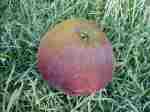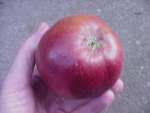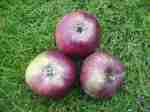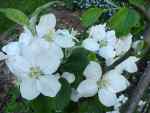
English Apples - Blackjack
BLACK JACK
Colin Rudling, of Shermanbury, West Sussex, recently asked
"Have you heard of a Black Jack apple? .......
I wonder if you could identify it from this description ....over 50 years ago a neighbouring farmer
(at Shermanbury) had in his garden an apple tree which bore fruit
completely dark red and flattened. The most striking feature was
that it was very, very hard; these apples could be found on the ground
in March in perfect condition, and they could be eaten by cutting
thin biscuit sized slices. They were quite sweet, according to my
grandmother, and the tree kept the farm workers in apples right
though the winter and spring. The tree is no longer standing, but
we called the apples Black Jacks".
........if anyone knows about these apples, or if you
know of a grafted Black Jack tree still in existence, Colin and I would like to hear
from you........N.D..
UPDATE...I have been contacted by a person in Surrey, T.W.,
who knows a of a local Black Jack tree. He has kindly supplied
a sample, and Colin has has identified them as the apple he
remembers. He has also sent some pictures (many thanks):
FURTHER UPDATE: Colin has grafted about a dozen
blackjack trees onto MM106; I also have one.
FRUIT
 .....
.....
 .....
.....
 .....
.....


BLOSSOM
 .....
.....
I am grateful to Alison Lean of Brogdale, who has found one
reference to this variety - it
was apparently exhibited at an apple conference in Sussex in 1934 and
is described
as dark red, flattened and very acidic, though no mention is
made of its
extremely late season.
This variety is not in the National Fruit Collection.
- Mel Wilson found a reference to Blackjack in HOGG:
WINTER COLMAN (Black Jack; Norfolk Colman ; Norfolk Storing]. Fruit, above medium size, three inches wide, and two inches and a quarter high ; roundish and flattened, obtusely angular on the side, and ribbed at the crown. Skin, yellowish green, with a tinge of dull red, on the shaded side, but deep dull mahogany brown on the side next the sun, which becomes clearer and more red as it attains maturity. Eye, with broad, erect, convergent segments, set in a rather shallow and plaited basin. Stamens, median, inclining to basal ; tube, conical. Stalk, short, thick, and deeply inserted. Flesh, firm, crisp, and briskly acid. Cells, round ; axile, closed.
A culinary apple of first-rate quality ; in use from November to April. The tree is a very strong and vigorous grower, so much so, that in its young state it is not a great bearer, but when grafted on the paradise stock it produces abundantly.
Other notes 2011, from own tree on MM106:
Strong, pleasant-flavoured large apple similar to Allen's Everlasting but less russeting, fairly acidic, juicy, crisp; good keeping quality; pick about early November for winter storage. The blossom is extremely white (see picture).
Vitamin C is quite high; measured as 7.4mg per 100g fruit in 2011.
- UPDATE .... In April 2012 I received an interesting email about this apple from Nathan S. Ivey, Virginia, USA. It read as follows:
.....When I was a boy growing up in Virginia in the US, I found an apple tree growing in the middle of the forest. It had these terrible looking ugly apples that I soon found were delicious! We had a small orchard at the house with a number of other varieties, but nothing compared to these mystery apples from this large old and gnarly tree in the forest full of woodpecker holes. At some point, my grandfather came to visit and I showed him these apples. He was thrilled and said that they were called Black Jack apples and that he hadn't seen any since he was a child. It's true that these apples will keep all winter in the root cellar. They are very crisp and sweet and just the loveliest apples with a delightful fragrance. Now I am looking for a Black Jack apple tree to remind me of those simpler times, when a shared apple could bring an old man and a young boy together...... Any leads on a Black Jack apple tree in the United States?
My reply:
Dear Nathan ......Blackjack apples over here are now extremely rare; when I started looking for a tree the last official mention I could find for these apples was in the 1930s.
They're not commercially available over here, and I don't think they are available in the USA either. I am interested to know how your grandfather knew about black jacks. was he from england? possibly from the fens? They come from norfolk, and their other name is 'winter colman'.
Dear Nigel - My grandfather was born in Virginia in 1913 and lived in the state his whole life. This varietal must have made it to Virginia by the teens or twenties at the latest, since he ate them as a kid. Virginia is arguably one of the better apple growing areas in the US. Perhaps I will have to take a trip back to the mountain of my youth to find a sapling. After I found the first one as a child, I found they were fairly numerous growing wild in that area and frequently sprouting up under the older trees.
(Text reproduced with Nathan's permission - many thanks....)
ND / Diversity website